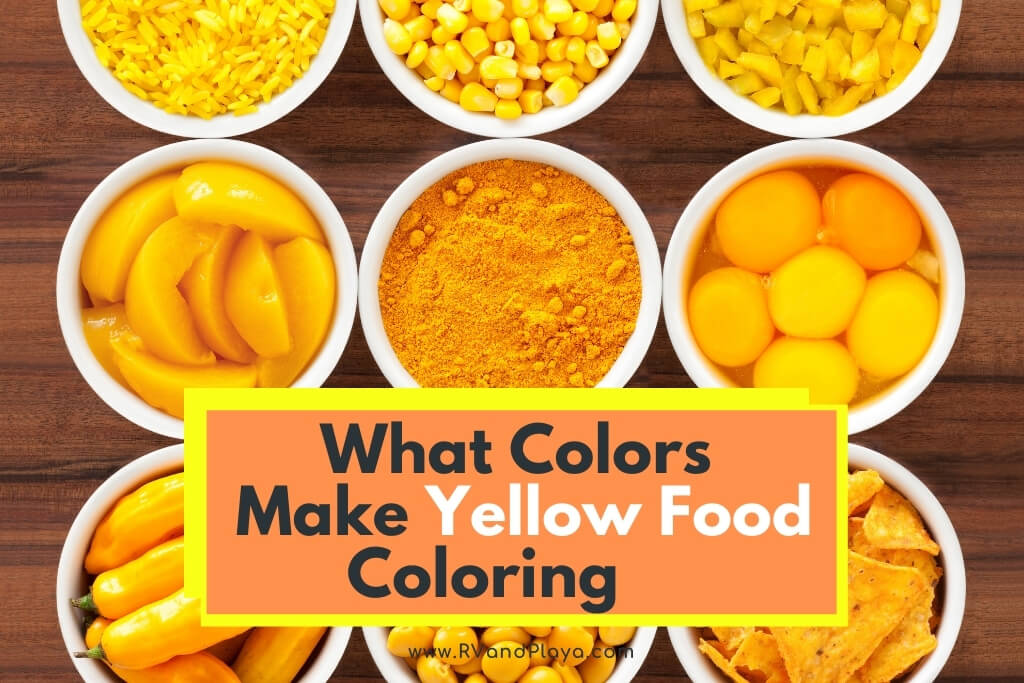Do you know what colors make yellow food coloring? this is one of the questions our readers ask a lot. Well, we´ve got you covered.
When it comes to making food coloring, it’s not just a combination of colors that will make yellow food coloring.
You can also use food to create yellow. Yellow is a primary color when it comes to paint and color additives but not as a prism.
So, what colors make yellow food coloring? A mixture of red and green food colors will change into yellow food coloring. That’s true for most paints and even prismatic combinations as well. You can also make yellow food coloring with food, for a more natural solution to any of your color needs.
Yellow food coloring is used in a lot of different foods commonly found in a cabinet or fridge, such as cereal and soda.
It was approved for use by the Food and Drug Administration in 1969. However, many scientific studies have linked food coloring with behavior disorders and sleeplessness in children.
Table of Contents
How To Make Yellow Food Coloring
If we’re talking just food colorings, you would want to introduce an exact ratio of 1:1 of green and yellow food coloring in a clean, separate container.
A higher percentage of either green or red will offset the color and you may not get the exact shade of yellow you’re looking for.
It has to be a pretty careful mix and you’ll want to do it slowly. Too much green will make the combination a lime green color while too little will change the color to a light brown.
Too much red, on the other hand, will also turn it brown, while too little will come out light green.
You can also make yellow food coloring by doing it the natural way.
This is a much better way to produce yellow food colors without resorting to extra artificial coloring. The best way to make it is to get some golden beets or turmeric.
- Start by peeling the beets and then dice them up really well
- Add ⅓ cup of water and two teaspoons of turmeric
- Put the entire mixture in the microwave for thirty seconds
- Remove it from the microwave and blend it until its puree
Once you have your mixture blended, grab some paper towels and use them to contain and squeeze the juice out of the mixture and into the container where you want your yellow food coloring.
You can also use mangoes and/or carrots to create yellow food coloring. Both require pretty much the same process that you use with golden beets and turmeric, except you’re not going to put turmeric in it.
Puree either the mangoes or the carrots or both. Microwave them for about thirty seconds and then strain them through a paper towel and into a container to hold the yellow coloring.
Read also: What Colors Make Rose Gold Food Coloring?
Is Natural Or Artificial Food Coloring Better?
Health-wise, natural food coloring is better without a question.
As far as getting the exact color you’re looking for without any added time or preparation, artificial food coloring is far simpler with less headache.
With artificial food coloring, you can add one color to another gradually until you get the color you want. Or, you can simply purchase the exact color you’re looking for.
Of course, every color you want may not be as easy to find in with artificial food coloring selections.
But you can always mix them according to color-mixing formulas that you can find anywhere on the web whenever you need them.
If you’re looking to use food coloring in a lot of food you or any children will probably consume, you may want to consider using the natural alternative to make the yellow food coloring you want.
While artificial food colorings were approved by the FDA, there are hundreds of studies out there that show artificial food coloring isn’t all that healthy, especially in children.
Artificial food coloring often contains aluminum, barium, and zirconium.
These metals are known to cause behavioral problems in children, as well as sleeping disorders.
Whether you subscribe to the current studies on artificial food coloring or not, creating colors with foods is an excellent alternative and also something kids can enjoy as well.
This is especially true for the Easter holiday. Natural yellow will combine with icing and/or eggs just as well as artificial colors.
The extra prep work and cooking involved can be a fun alternative to just pulling out a bunch of plastic bottles that are ready to go.
Read also: What Do You Get When You Mix Red And Yellow? (Color Wheel)
Color Mixing Chart
All Things Considered
Combining red and green will always produce yellow, so long as you keep it exactly half and half, without going overboard with the red or the green.
You can also create natural food coloring—red or green—and combine those to make yellow.
Lastly, you could just make your own yellow food coloring from golden beets, turmeric, fresh mangoes, or carrots.
Whichever method you decide on, making yellow food coloring isn’t a difficult process by any means.
Here are some of my favorite services, products, and Stores
There are affiliate links, so if you do decide to use any of them, I´ll earn a small commission. But in all honesty, these are the exact what I use and recommend to everyone, even my own family.
To see all my of most up-to-date recommendations, check out this resource that I made for you!
+ Products & Services
+ Convenience Stores
+ Save Thousands of Dollars
References
https://blog.wilton.com/icing-coloring-color-chart/
https://www.leaf.tv/articles/how-to-mix-food-coloring-to-make-different-colors/
Recent Posts
Have you ever wondered what do you get when you mix red and yellow? If you have primary and neutral colors, you could mix nearly any shade you imagine. With just a few shades of paint, you could...
What Do You Get When You Mix Red and Green? (Three Colors of Light)
Wondering what you will get when you mix red and green color? Life is full of beautiful colors. As humans, we can perceive such an array of colors to enjoy the entire rainbow and varying shades of...



